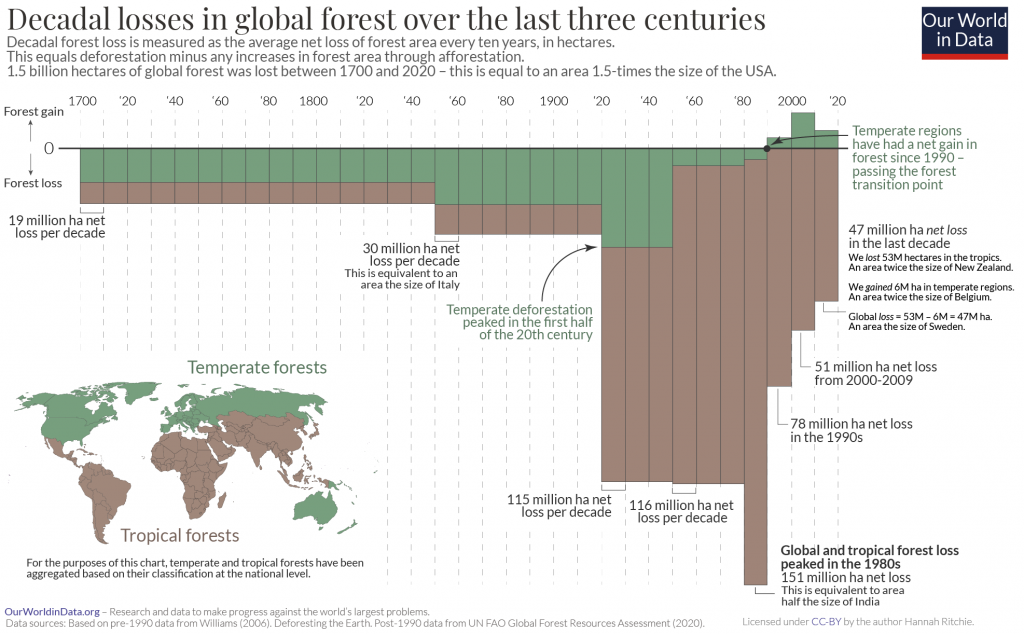How Sustainable Is Teak Wood? Here Are the Facts
Impactful Ninja is reader-supported. When you buy through links on our site, we may earn an affiliate commission.
Learn more
Learn more
.
Hey fellow impactful ninja ? You may have noticed that Impactful Ninja is all about providing helpful information to make a positive impact on the world and society. And that we love to link back to where we found all the information for each of our posts. Most of these links are informational-based for you to check out their primary sources with one click. But some of these links are so-called "affiliate links" to products that we recommend. First and foremost, because we believe that they add value to you. For example, when we wrote a post about the environmental impact of long showers, we came across an EPA recommendation to use WaterSense showerheads. So we linked to where you can find them. Or, for many of our posts, we also link to our favorite books on that topic so that you can get a much more holistic overview than one single blog post could provide. And when there is an affiliate program for these products, we sign up for it. For example, as Amazon Associates, we earn from qualifying purchases. First, and most importantly, we still only recommend products that we believe add value for you. When you buy something through one of our affiliate links, we may earn a small commission - but at no additional costs to you. And when you buy something through a link that is not an affiliate link, we won’t receive any commission but we’ll still be happy to have helped you. When we find products that we believe add value to you and the seller has an affiliate program, we sign up for it. When you buy something through one of our affiliate links, we may earn a small commission (at no extra costs to you). And at this point in time, all money is reinvested in sharing the most helpful content with you. This includes all operating costs for running this site and the content creation itself. You may have noticed by the way Impactful Ninja is operated that money is not the driving factor behind it. It is a passion project of mine and I love to share helpful information with you to make a positive impact on the world and society. However, it's a project in that I invest a lot of time and also quite some money. Eventually, my dream is to one day turn this passion project into my full-time job and provide even more helpful information. But that's still a long time to go. Stay impactful,Affiliate Disclosure
Why do we add these product links?
What do these affiliate links mean for you?
What do these affiliate links mean for us?
What does this mean for me personally?
![]()
Teak is the perfect wood for many household projects because it is strong, water-resistant, and rot-resistant. A teak garden table would last for decades and age gracefully while requiring very little care. However, high demand for this valuable hardwood drives illegal logging in old-growth tropical forests, causing great biodiversity loss. So we had to ask: How sustainable is it to buy products made out of teak wood?
Teak wood is generally a sustainable wood thanks to carbon sequestration and carbon storage. However, the high eco-cost of tropical forest deforestation due to teak logging and the long transporting distances make this tropical timber less sustainable than timber from more local, temperate forests.
In this article, we’ll walk you through the life-cycle of teak wood used for household projects like garden decking or a chair. Then, we evaluate its sustainability, potentials, and shortfalls. And in the end, we’ll show you tips for buying sustainable teak wood.
Here’s How Sustainable Teak Wood Is
Teak is a tropical hardwood ideal for outdoor projects because it is impervious to weather extremes and rotting. There are two sources of teak timber: plantations and native forests. Each option has its own limitation, leaving teak a much less sustainable wood choice than timber from temperate forests like pine or oak. Still, it is important to note that any wood is better for the environment than plastic, especially when sourced from sustainably managed forests.
“Sustainable: The ability to be maintained at a certain rate or level | Avoidance of the depletion of natural resources in order to maintain an ecological balance”
Oxford Dictionary
To understand the sustainability of teak wood, we assess the life-cycle of household projects like a table or garden decking. This life-cycle assessment (LCA) is a method to evaluate the environmental impacts of each stage in a product’s life-cycle, from the making to the recycling. Over the years, companies have strategically used LCA to research and create more sustainable products.
In this article, we’ll use the cradle-to-grave perspective of the LCA, examining the five stages of the life-cycle of furniture made with teak wood. Where it is relevant, we also use data from cradle-to-gate assessments.
| The life-cycle stages of teak wood | Each stage’s sustainability |
| Growing of teak wood | In their native forests, teak trees grow sustainably because of carbon sequestration and carbon storage in the tree and its rooting system. However, illegal or ill-managed logging practices can cause much damage to tropical teak forests and their biodiversity. Growing teak trees in plantations might have a lower eco-cost, especially when agroforestry practices are applied. |
| Manufacturing of teak wood | Turning teak wood into furniture can have a relatively low carbon footprint when wood waste is utilized to make by-products or biomass pellets to offset the carbon emissions during harvesting and processing. |
| Transporting of teak wood | Transporting teak timber and furniture has a high carbon footprint, especially when furniture is sold in the US and Europe, far away from native teak forests. |
| Usage of teak wood | The usage of teak wood is sustainable because of the products’ long lifespan. |
| End-of-life of teak wood | The end-of-life of teak wood is sustainable as the product can be upcycled or recycled for biomass energy. |
We’ll say that it is possible to find sustainable teak products. However, the actual environmental impact of a particular product, like a table or garden decking, depends on many factors, especially the forest management practices and the distance and mode of transportation. Let’s dive deeper into each stage and find out how it can be more sustainable.
How Sustainable Is the Growing Teak Wood
In their native forests, teak trees grow sustainably because of carbon sequestration and carbon storage in the tree and its rooting system. However, illegal or ill-managed logging practices can cause much damage to tropical teak forests and their biodiversity. Growing teak trees in plantations might have a lower eco-cost, especially when agroforestry practices are applied.
What Type of Wood is Teak and What Does This Mean for Sustainability
Teak, or Tectona grandis, is a tropical hardwood tree. Teak trees are reported to reach up to 19 inches (48 cm) in diameters and 100 feet (30 m) in height in 40 years. The growth rate is often higher during the initial years then slows down. In the forests, a teak tree typically takes 80 to 120 years to mature. In plantations, teak trees can be harvested earlier, around 60 years.
In both native forests and plantations, teak trees take longer to mature than softwood trees like pine or Douglas fir. And this slower replacement rate makes teak less sustainable than softwoods.
How Sustainable Does Teak Wood Grow
The alarming problem about the sustainability of harvesting teak wood is the diminishing natural habitat, especially due to the illegal logging in Myanmar – home of the majority of teak trees.
- Diminishing critical natural habitats: The high demand for teak, especially in China, Europe, and the US, drives unsustainable and often illegal logging practices in Southeast Asia’s primary tropical forests. In Myanmar, where roughly half of Earth’s wild teak trees grow, over and illegal logging of teak has been sweeping through its rainforests for more than a century. Tropical rainforests have incredible and unmatched biodiversity. When loggers bulldoze roads into those pristine forests to seek the high-value teak trees, they kill wild animals and threaten their habitat, leading to mass distinction of plants and animals that have occurred on Earth in 65 million years.
However, when teak trees are grown in sustainably managed forests and plantations, the carbon sequestration and the potential for diverse land use means using the wood could be relatively sustainable.
- Carbon sequestration: The carbon sequestration potential of teak trees is significant. As they grow, they absorb CO2 from the atmosphere while releasing oxygen. During their lifespan, which could last a few hundred years, they act as a carbon sink. This means that they are taking greenhouse gases out of the atmosphere, helping to mitigate the climate crisis. And they can store a lot, growing as tall as 130 feet with a truck of 3 – 5 feet in diameter.
- Diverse land usage: As the number of teak trees growing in the wild reduces, teak timber from plantations becomes a more sustainable option, especially when forestry operations move away from monoculture. For example, the introduction of silvopastoral systems (systems that combine tree growing with the production of livestock) can help increase biodiversity in teak plantations.
- Agroforestry incentives, like these, see more crops growing between teak lines, bringing extra income for farmers while waiting for teak trees to mature.
Where Is Teak Wood Usually Grown
Teak trees grow naturally in only four South and Southeast Asia countries: Myanmar, India, Laos, and Thailand. Myanmar’s tropical forests are home to almost half of the world’s wild teak trees. It is also the only country that allows commercial export of teak timber from natural forests. India, Lao PDR, and Thailand, on the other hand, have bans on logging in natural forests or exporting teak logs.
Harvesting teak wood from natural forests, especially when it is illegal or ill-managed, results in biodiversity loss. One example is when loggers only cut down the biggest and tallest trees. That pattern would cause a reduction in the genetic diversity and quality of the trees within the stand, leading to gradual degradation of tree quality.
Cutting down teak trees also disrupts the forests’ wild animals, which is highly diverse in tropical teak forests. Scientists from the Delft University of Technology have developed an indicator for the “eco-costs of land-use,” which factors in the environmental price of biodiversity (loss). They calculated that such cost for a piece of decking is about 25 times higher when made with old-growth teak from an FSC-certified forest instead of new-growth teak from a plantation (or wild pine).
In total, logging of forestry products from plantations accounts for 26% of forest loss, which is a combination of deforestation and forest degradation. However, the loss in bio-diverse forests in tropical climates is more significant (and sometimes less properly recorded) than in temperate, well-managed logging forests.

Because of the decrease of teak population in natural forests and the ban on wild teak exports in some countries, teak trees are increasingly planted in plantations across Asia, Africa, Central, and South America. Today, a high percentage of teak comes from plantations in Indonesia, India, Myanmar, the Philippines, and Malaysia.
Large-scale industrial timber plantations focusing on high-value species like teak can be problematic because they tend to harbor much less biodiversity than the natural tropical forest areas they replace. However, when used, silvopastoral systems (systems that combine tree growing with the production of livestock) can increase the biodiversity of a plantation, making the timber more sustainable.
How Sustainable Is the Manufacturing of Teak Wood
Turning teak wood into furniture can have a relatively low carbon footprint when wood waste is utilized to make by-products or biomass pellets to offset the carbon emissions during harvesting and processing. Significant reduction in carbon emissions can also come from using fossil-free energy.
The first step of manufacturing teak furniture involves cutting down trees and turning them into lumber in a sawmill. Sawing is an electricity-consuming step.
The next step is to dry lumber and turn it into furniture. Teak is a slow-drying wood. It can take up to 2 years to air dry teak logs. Kiln-drying teak to a moisture content of 8% – the ideal moisture content for making outdoor furniture – takes about three weeks. A significant part of the energy required for kiln-drying can come from burning wood waste. At least 90% of all thermal energy used for kiln drying in the US hardwood sector is derived from biomass.
In a cradle-to-crave assessment of a teak chair made in Java, Indonesia, then exported to Europe, teak log production accounts for 15% of the total CO2 emissions attributed to this teak chair.
Tropical woods like teak do not require surface treatment thanks to a high content of natural oils, protecting the wood from fungi and pests. And no surface treatment means that less energy is needed for producing and applying the treatment. And also that the furniture can be recycled fully at the end of its life, making it more sustainable.
How Sustainable Is the Transportation of Teak Wood
Transporting is a carbon-intensive stage in the life cycle of teak furniture due to the emissions associated with operating the hauling vehicles that take timber to sawmills and factories, then furniture to stores.
As teak timber in the US could have come from places as far as Southeast Asia, teak furniture would have a higher carbon footprint than furniture made with regionally available wood, like Douglas Fir or maple.
The actual emission during the transporting stage depends on the type of vehicles used, the fuel they need, and the distance the wood travels. Calculations made by the Norwegian Forest and Landscape Institute showed that smaller wood hauling trucks emitted more CO2 per transported cubic meters of timber: 1.25 times more than larger wood hauling trucks, 1.3 times more than sea vessels, and six times more than freight trains. Therefore, the sustainable transportation option would be rail or large trucks running on biofuel. You can check with your wood suppliers how their products are transported to and within the US and opt for the more sustainable option.
In the same cradle-to-crave assessment of a teak chair from above (the one, made in Java, Indonesia, and then exported to Europe), teak distribution accounts for 57% of the total CO2 emissions. More than half of the resources (such as diesel) used to transport the chair come from non-renewable sources.
How Sustainable Is the Usage of Teak Wood
Using teak furniture can be sustainable thanks to the carbon capture during the products’ long life.
Teak is a close-grain, hard, and durable wood. The timber is known for its resistance to termite, fungus, and weathering. And in terms of lifespan, outdoor products made of teak wood, such as a table or garden decking, can last many decades, and indoor products can last a lifetime.
When deck wood is decayed, either naturally in the forest or because of damage caused by usage at home, the carbon stored in the wood is released back to the atmosphere. Therefore, long-lasting furniture can be considered a good way of keeping carbon out of the atmosphere. If the wood is then reclaimed for making another piece of furniture, its positive carbon storage environmental impact is even higher.
How Sustainable Is the End-of-Life of Teak Wood
The end-of-life stage for teak furniture is sustainable when the wood is reused or burned as bioenergy.
There are a few scenarios for wood products – furniture, flooring, and household items – at the end of their life.
They can end up in landfills and don’t decompose. In this case, they’d keep their role as carbon storage.
Wood products can also be upcycled and reused, extending their role as carbon storage and reducing the fossil CO2 emitted as much as four times when comparing, for example, a recovered hardwood flooring with a new one. New wood products often travel much further to their markets, in the case of teak, from South Asia to North America, compared with recovered wood products. The latter is typically made in urban centers and sold locally, which lowers the transportation environmental burdens.
In another end-of-life scenario, products like an ipe fence can be burned for biomass energy displacing coal or natural gas in generating electricity.
With smaller household items, like a doorknob or a small chair, the offset won’t be as high as there is much less waste for burning. However, if such products are made from manufacturing wood waste as by-products, their carbon footprint is minimal.
In a life-cycle assessment of a piece of decking made from different woods, the carbon emissions of decking made with old-growth teak wood from natural forest and new-growth planted teak wood are around and below zero. While these woods do have their environmental costs, they are much more sustainable considering the CO2 emissions than materials like wood plastic composite.
How Can You Buy Teak Wood More Sustainably
The key to sustainably buying any wood is to check on relevant environmental and original certifications. Reliable certifications for sustainable woods are:
An FSC certification ensures that the teak wood comes from responsibly managed forests that provide environmental, social, and economic benefits.
PEFC’s approaches to sustainable forest management are in line with protecting the forests globally and locally and making the certificate working for everyone. Getting a PEFC certification is strict enough to ensure the sustainable management of a forest is socially just, ecologically sound, and economically viable but attainable not only by big but small forest owners.
Because there is a high risk of illegal or over logging for teak timber, make sure you only buy teak furniture with an FSC or PEFC certification.
Why Is It Important to Buy More Sustainable Wood
Buying sustainable wood also means helping to prevent illegal or unsustainable logging, which harms the forests’ biosystems and accelerates climate change.
Logging of forestry products from plantations accounts for 26% of forest loss. Cutting down trees for wood has a lesser impact on carbon storage than digging up the whole forest floor and turning it into farms or mines. However, if logging is not sustainably managed, it can badly damage wildlife.
When logging happens in tropical forests – the bio hotspots of our planet – the biodiversity loss can be much more damaging. Subtropical and tropical forests are packed with unique wildlife – endemic mammals, birds, and amphibians. The displacement of such wildlife during poorly managed logging would be a major contributor to global biodiversity loss.
Sustainable management of forests also means that trees are cut down for timber only when they are mature. These trees will then be able to regrow and eventually replace the loss of canopy, absorb carbon from the atmosphere and reduce the effect of climate change.

Final Thoughts
You can buy sustainable furniture made from teak wood as long as the material comes from sustainably managed forests. However, because teak is an imported tropical wood, it has a much higher transporting carbon footprint than hardwoods from temperate forests in the US. If you decide to buy teak furniture, make sure to use any piece for as long as you can, upcycle the material to extend its usage, and arrange for it to be recycled fully.
Stay impactful,

Sources
- Impactful Ninja: How Sustainable Is Pine Wood? Here Are the Fact
- Impactful Ninja: How Sustainable Is White Oak Wood? Here Are the Fact
- Reuters: Ditch metal and plastic and turn to wood to save the planet, says U.N.
- Science Direct: Life-cycle assessment (LCA)
- MIT SMR: Strategic Sustainability Uses of Life-Cycle Analysis
- European Environment Agency: cradle-to-grave
- Science Direct: Cradle-to-Gate Assessment
- SCIELO: Growth rate and ring width variability of teak, Tectona grandis (Verbenaceae) in an unmanaged forest in East Timor
- WOOD MAGAZINE: Teak
- NATIONAL GEOGRAPHIC: After a century of logging, Myanmar struggles to preserve its teak groves
- Rainforest Relief: Guidelines for Avoiding Wood from Endangered Forests
- Research Gate: Socio-economic and environmental impacts of teak monoculture plantations in Sri Lanka
- FAO: Natural teak forests decline, while planted teak forests increase
- Accoya: Life Cycle Assessment of Accoya Wood and its applications
- Our World in Data: Deforestation and Forest Loss
- Science Direct: Silvopastoral Systems
- GOLDEN TEAK: Kiln Drying Teak Wood
- European Commission: Study and Assessment of Available Information for a Pilot Project on a Teak Garden Chair
- American Hardwood: Environmental Life Cycle Assessment
- Natustyrelsen: Purchasing Tropical Timber
- Impactful Ninja: How Sustainable Is Douglas Fir Wood? Here Are the Fact
- Impactful Ninja: How Sustainable Is Maple Wood? Here Are the Fact
- Science Norway: Larger logging trucks give less CO2 emissions
- Research Gate: Life cycle primary energy and carbon analysis of recovering softwood
- Forest Stewardship Council
- Program for Endorsement of Forest Certification
- Our World in Data: Epidemic Mammal Species




